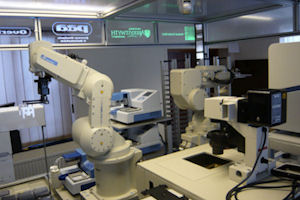Graphine and a flexible future for technology:
 A future of flexible electronics may be just around the corner, as researchers from the Universities of Manchester and Sheffield combine forces to show that 2D ‘designer materials’ can be customised to create flexible, see through and more efficient electronic devices.
A future of flexible electronics may be just around the corner, as researchers from the Universities of Manchester and Sheffield combine forces to show that 2D ‘designer materials’ can be customised to create flexible, see through and more efficient electronic devices.
The research group, lead by Nobel Laureate Sir Kostya Novoselov, showed that graphine and related 2D materials can be manipulated to create light emitting tech for the next generation of mobile phones, tablets and televisions.
This amazing technology sees researchers stacking layers of 2D materials (such as graphine, boron nitride and molybdenum disulphide) into thin flexible sheets called heterostructures. These sheets can be 10-40 atoms thick and, with the introduction of quantum wells to control movement of electrons, can emit light across their whole surface. Explaining the creation of the LED device Sir Kostya Novoselov said: “By preparing the heterostructures on elastic and transparent substrates, we show that they can provide the basis for flexible and semi-transparent electronics.”
Freddie Withers, Royal Academy of Engineering Research Fellow at The University of Manchester, who led the production of the devices, said: “As our new type of LED’s only consist of a few atomic layers of 2D materials they are flexible and transparent. We envisage a new generation of optoelectronic devices to stem from this work, from simple transparent lighting and lasers and to more complex applications.”
This work, published in the scientific journal Nature Materials, may be set to revolutionise the future of electronic technology.
Hope for better implantation rates in IVF patients:
 For many couples with fertility problems IVF may be the last hope when it comes to starting a family. Unfortunately, despite a wealth of success stories, IVF embryos only have around a 25% chance of developing to term – predominantly due to high rates of failure when embryos attempt to implant into the uterine wall. Novel research from the University of Manchester is now exploring embryonic implantation and findings suggest that this work may lead to increased IVF success rates.
For many couples with fertility problems IVF may be the last hope when it comes to starting a family. Unfortunately, despite a wealth of success stories, IVF embryos only have around a 25% chance of developing to term – predominantly due to high rates of failure when embryos attempt to implant into the uterine wall. Novel research from the University of Manchester is now exploring embryonic implantation and findings suggest that this work may lead to increased IVF success rates.
Altered levels of microRNA have been found in the endometrium (uterine lining) of women who are prone to IVF implantation failures. One microRNA (microRNA-145) and its target receptor (Insulin-like growth factor – IGF1R), are now causing a stir, as studies reveal a previously unknown role for this microRNA and its receptor in the embryonic attachment process.
Professor John Aplin, who led the study said: “When an embryo is ready for implantation, its replacement is carefully timed to coincide with the window of maximal receptivity in the uterus.
“This window is open for no more than four days. Our study suggests that the presence of IGF1R during this period is required for the embryo to stick to the uterus.”
It seems that increased levels of microRNA-145 could inhibit production of IGF1R, leading to failures in embryonic implantation. Although this work is still in its infancy, and more research is needed to confirm this observation; Professor Alpin believed that treatments which suppress microRNA-145 may improve rates of attachment, saying – “This is one of the hardest groups of women to treat in fertility science and rates are still very low across the board. Repeated IVF cycles are stressful and can be expensive too. Greater understanding of the mechanisms which control success or failure can lead directly to treatments to make IVF cycles more efficient so that infertile couples can start their families.”
The full paper: miR-145 suppresses embryo-epithelial juxtacrine communication at implantation by modulating maternal IGF1R’, published in the Journal of Cell Science can be read here.
Robotic scientists join the hunt for the next big medical breakthrough:
Medical science has a vast and growing library of chemical compounds at its disposal. These compounds are a bit like keys, although many may prove useless, others could unlock the door to previously unknown treatments. The problem is finding the time and resources to test all possible combinations.
Enter Eve; an artificially-intelligent Mancunian ‘robot scientist’ designed to make drug discover faster, cheaper and more efficient.
When put to task, Eve can screen over 10,000 compounds per day in the search for new life saving treatments. But, ‘she’ is much more than just a high throughput drug screening device. “Eve exploits inbuilt artificial intelligence to learn from early successes in her screens and select compounds that have a high probability of being active against the chosen drug target. A smart screening system, based on genetically engineered yeast, is used. This allows Eve to exclude compounds that are toxic to cells and select those that block the action of the parasite protein while leaving any equivalent human protein unscathed. This reduces the costs, uncertainty, and time involved in drug screening, and has the potential to improve the lives of millions of people worldwide.”
Scientists from the Universities of Manchester, Cambridge and Aberystwyth have demonstrated Eve’s capabilities by using her skills to uncover a compound, previously investigated for its anti-cancer properties, which may also be used in the fight against malaria. This compound inhibits a key molecule in the malaria parasite known as DHFR and may be just what is needed to cope with newly emerging strains of drug resistant malaria.
Steve Oliver from the Cambridge Systems Biology Centre and the Department of Biochemistry at the University of Cambridge says: “Every industry now benefits from automation and science is no exception. Bringing in machine learning to make this process intelligent – rather than just a ‘brute force’ approach – could greatly speed up scientific progress and potentially reap huge rewards.” “Despite extensive efforts, no one has been able to find a new antimalarial that targets DHFR and is able to pass clinical trials,” adds Professor Oliver. “Eve’s discovery could be even more significant than just demonstrating a new approach to drug discovery.”
Original press releases can be found here.

